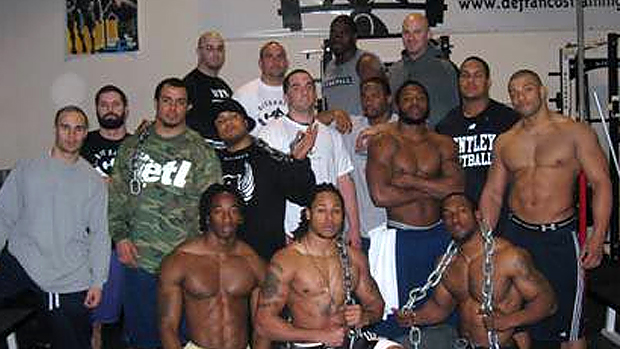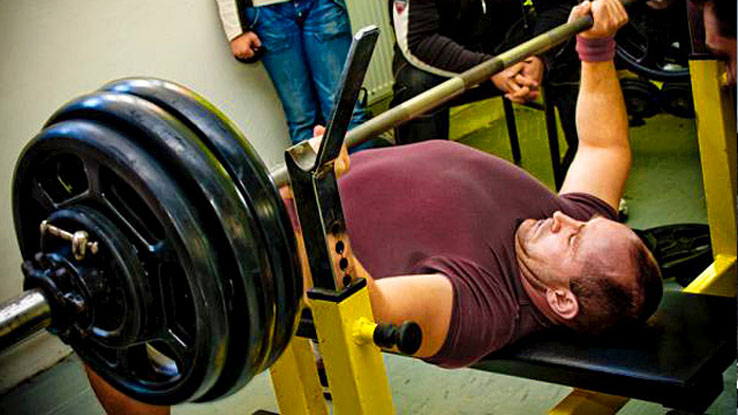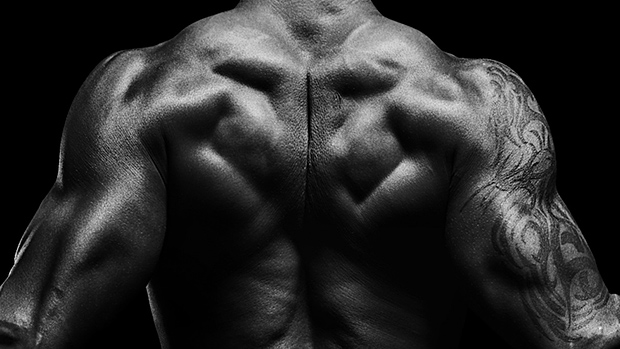Ask any eight-year old to show you how strong they are and they'll instinctively grab the nearest object and triumphantly hoist it overhead. It's in our DNA. Overhead pressing is one of the fundamental ways that we express practical strength.
But for many, pain, injuries, poor mobility, and bad programming have turned the air overhead into a no-fly zone for loaded exercises – cutting off a major artery for muscle growth and leaving a blank space in their shoulder training.
There's good news for those who equate overhead pressing with sleepless nights of searing shoulder pain, though: There are still plenty of ways to build an imposing silhouette below the 180-degree pain barrier of movement.
Here are four shoulder-broadening supersets that will make your shoulders pop like Thanksgiving pumpkins... without pissing off your joints.
The landmine press is a more user-friendly version of the traditional military press. It allows you to continue to perform a heavy, multi-joint pressing motion when regular overhead presses hurt. It's also a sneaky way of maintaining pushing volume when you can't bench press.
The angle of the shoulder is somewhere between a vertical and horizontal press, which makes more space for the rotator cuff tendons so they don't get sandwiched – as in the case of a military press – and steers you clear of anterior shoulder pain – as in the case of the bench press.
Lateral raises make an ideal superset companion to landmine presses. Unfortunately, they get an unfair rep outside of bodybuilding circles as being too fluffy or, well, too bodybuildery. It's too bad because lateral raises are a great way to isolate and exhaust the medial delts and traps without accumulating a lot of axial fatigue.
By using a cable instead of a dumbbell, and by leaning away from the machine, you're able to flatten the resistance curve – the natural change in leverage that occurs throughout the range of motion. The resistance curve is why lateral raises are so hard at the top and easy at the bottom, but by flattening it out – courtesy of the cable – you'll be taxing local fibers evenly throughout the arc, not just when your arm gets above 45-degrees.
To pair these two movements optimally, follow this pattern:
- Landmine Press Left
- Landmine Press Right
- Cable Lateral Raise Left
- Cable Lateral Raise Right
Most people lump rear delts and upper traps in with their back training, but his area is ground zero if you want to have an upper back that looks like an Olympic gymnast's. They deserve their own time slot.
Plus, both movements here are joint-friendly, draw a huge amount of blood into the area for an intense pump, and allow you to maintain a regional training effect even when you're nursing an injury.
For the rear delt flye, set-up an incline bench like you would for a chest-supported row. This will give you a reference point for your body position and will decrease rocking.
Place a heavy dumbbell a few feet in front of the bench and loop a stretch band around it – one with handles, preferably. Grab a pair of dumbbells and the handles of the band and pull up and back.
The dumbbells provide a vertical force vector – pushing down in a straight line toward the earth – while the band creates a diagonal resistance (oriented at about 45-degrees) that supercharges the standard dumbbell version of this exercise.
Immediately afterward, segue into conventional dumbbell shrugs, keeping the weight heavy.
Feet-elevated push-ups are like closed-chain military presses performed in the same plane as a landmine press. As such, the magic here is the angle of the shoulder, which is about 110-130 degrees of overhead flexion. Plus, you get the added benefit of involving the serratus anterior, which facilitates upward rotation of the scapula, retraction of the rib cage, and expansion of the upper back as you push your body away from the ground.
Where push-ups create an expansion, face-pulls create compression – two sides of the same coin that balance muscular forces around the shoulder. Just like the yin and yang of the biceps and triceps, you see a natural, reciprocal power and equilibrium from pairing opposites.
This pairing takes opposing muscles – on the front and back of the shoulder – and works them up and down along the scapular plane, approximately 30-45 degrees from the midline of the body.
Keeping the hands in a thumbs-up position during the chain full-cans rotates the head of the humerus inside the shoulder to create more sub-acromial space. This acts like a pressure release valve to give the soft-tissue structures inside more room to maneuver.
Dumbbells work fine, but chains are more fun. They spike the resistance curve, concentrating the most amount of weight at the top where your leverage is worst. This provides a contrast to accommodating resistance – where the weight increases in proportion to your leverage.
Pair the chain full-cans with rear-delt descending cable flyes:
This is a take on the traditional dumbbell rear delt flye, except – because of the physics of cable loading – there's continuous tension over the entire range of motion.
I also like to pitch the angle from high-to-low to bring in the lats, similar to raising your arms a little above shoulder height during a lateral raise to draw in the traps.





